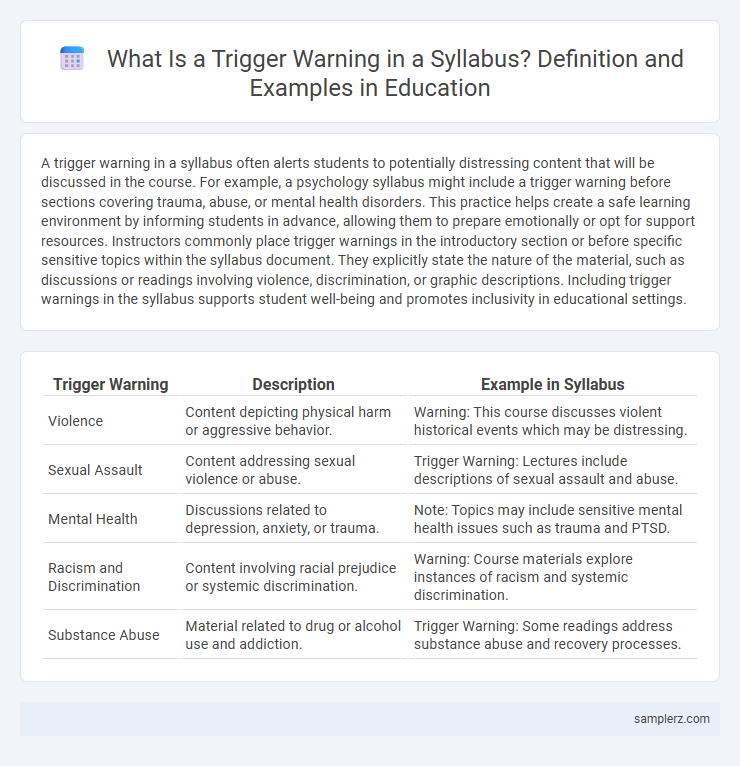A trigger warning in a syllabus often alerts students to potentially distressing content that will be discussed in the course. For example, a psychology syllabus might include a trigger warning before sections covering trauma, abuse, or mental health disorders. This practice helps create a safe learning environment by informing students in advance, allowing them to prepare emotionally or opt for support resources. Instructors commonly place trigger warnings in the introductory section or before specific sensitive topics within the syllabus document. They explicitly state the nature of the material, such as discussions or readings involving violence, discrimination, or graphic descriptions. Including trigger warnings in the syllabus supports student well-being and promotes inclusivity in educational settings.
Table of Comparison
| Trigger Warning | Description | Example in Syllabus |
|---|---|---|
| Violence | Content depicting physical harm or aggressive behavior. | Warning: This course discusses violent historical events which may be distressing. |
| Sexual Assault | Content addressing sexual violence or abuse. | Trigger Warning: Lectures include descriptions of sexual assault and abuse. |
| Mental Health | Discussions related to depression, anxiety, or trauma. | Note: Topics may include sensitive mental health issues such as trauma and PTSD. |
| Racism and Discrimination | Content involving racial prejudice or systemic discrimination. | Warning: Course materials explore instances of racism and systemic discrimination. |
| Substance Abuse | Material related to drug or alcohol use and addiction. | Trigger Warning: Some readings address substance abuse and recovery processes. |
Understanding Trigger Warnings in Educational Syllabi
Trigger warnings in educational syllabi alert students to potentially distressing content, such as discussions of trauma, violence, or sensitive social issues. Including these warnings promotes an inclusive learning environment by preparing students emotionally and allowing them to engage with course material at their own pace. Examples include notes about upcoming graphic literature, historical accounts of conflict, or discussions involving mental health topics.
Importance of Trigger Warnings for Student Well-being
Including trigger warnings in syllabi helps create a safe and supportive learning environment by alerting students to potentially distressing content such as graphic violence, sexual assault, or mental health issues. This advance notice allows students to prepare emotionally or opt out of specific materials without penalty, promoting psychological safety and reducing anxiety. Emphasizing trigger warnings underscores institutional commitment to student well-being and fosters inclusivity in diverse educational settings.
Common Topics Needing Trigger Warnings in Courses
Common topics needing trigger warnings in courses include discussions on sexual violence, mental health issues, racial discrimination, and trauma-related experiences. Including trigger warnings in the syllabus helps prepare students emotionally and ensures a supportive learning environment. Clear communication about sensitive content encourages informed consent and fosters academic engagement.
Sample Trigger Warning Statements in Syllabi
Sample trigger warning statements in syllabi include alerts about potentially distressing content such as graphic violence, discussions of sexual assault, or topics related to mental health struggles. These statements aim to prepare students emotionally and provide them opportunities to seek support or opt out of specific material. Incorporating clear and specific trigger warnings fosters an inclusive educational environment that respects diverse student experiences and promotes well-being.
Best Practices for Drafting Trigger Warnings
Best practices for drafting trigger warnings in a syllabus include clearly identifying potentially distressing content such as graphic violence or sensitive trauma, using concise and specific language to inform students without overwhelming them. Incorporating trigger warnings at the beginning of relevant sections allows students to prepare mentally or opt out, promoting a respectful and inclusive learning environment. Consistently updating warnings based on student feedback and evolving course materials ensures that content warnings remain relevant and effective.
How Professors Communicate Trigger Warnings
Professors communicate trigger warnings in syllabi by clearly stating potential sensitive content related to the course material, such as graphic descriptions or discussions of trauma. These warnings are often positioned at the beginning of relevant sections or units to give students prior notice and prepare for emotional impact. Including trigger warnings fosters a considerate learning environment while respecting diverse student experiences and promoting mental health awareness.
Adapting Syllabus Language for Sensitive Content
Incorporating trigger warnings in syllabi involves carefully adjusting language to acknowledge potentially sensitive topics like trauma, mental health, or violence without discouraging academic engagement. Specific phrases such as "This course includes discussions on [topic], which may be distressing to some students" help create a supportive learning environment while maintaining academic rigor. Clear, respectful wording allows educators to balance transparency with inclusivity, ensuring students can make informed decisions about their participation.
Legal and Ethical Considerations of Trigger Warnings
Including trigger warnings in a syllabus addresses legal and ethical considerations by respecting students' psychological safety and minimizing potential harm from course content. Institutions may face legal implications if they fail to accommodate students with trauma-related conditions under disability laws such as the Americans with Disabilities Act (ADA). Ethical practices emphasize transparency and student autonomy, allowing learners to prepare for or opt out of distressing material while maintaining academic integrity.
Impact of Trigger Warnings on Learning Environments
Trigger warnings in syllabi, such as alerts before discussing trauma-related content, can create safer learning environments by allowing students to prepare emotionally and mentally. Research indicates that these warnings reduce anxiety and foster inclusivity, promoting better engagement and participation. Critics argue they may hinder resilience, but evidence generally supports their positive impact on student well-being and academic performance.
Student Feedback on Syllabus Trigger Warnings
Student feedback on syllabus trigger warnings highlights a growing demand for sensitivity in course materials to foster a safe learning environment. Many students report increased comfort and preparedness when potential distressing content is clearly identified in advance. Educators find that including trigger warnings can enhance student engagement and promote open dialogue while respecting diverse emotional needs.

example of trigger warning in syllabus Infographic
 samplerz.com
samplerz.com